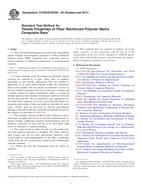Wir benötigen Ihre Einwilligung zur Verwendung der einzelnen Daten, damit Sie unter anderem Informationen zu Ihren Interessen einsehen können. Klicken Sie auf "OK", um Ihre Zustimmung zu erteilen.
ASTM D7205/D7205M-06(2011)
Standard Test Method for Tensile Properties of Fiber Reinforced Polymer Matrix Composite Bars
Automatische name übersetzung:
Standardtestverfahren für Zugeigenschaften von faserverstärkten Polymermatrix-Verbund Bars
NORM herausgegeben am 1.8.2011
Informationen über die Norm:
Bezeichnung normen: ASTM D7205/D7205M-06(2011)
Anmerkung: UNGÜLTIG
Ausgabedatum normen: 1.8.2011
SKU: NS-37857
Zahl der Seiten: 13
Gewicht ca.: 39 g (0.09 Pfund)
Land: Amerikanische technische Norm
Kategorie: Technische Normen ASTM
Kategorie - ähnliche Normen:
Die Annotation des Normtextes ASTM D7205/D7205M-06(2011) :
Keywords:
tensile properties, tensile strength, tensile modulus of elasticity, bars, composite materials, composite bars, ICS Number Code 91.100.40 (Products in fibre-reinforced cement)
Ergänzende Informationen
| Significance and Use | ||||||||||||||||||||||||||||||||||
|
This test method is designed to produce longitudinal tensile strength and elongation data. From a tension test, a variety of data are acquired that are needed for design purposes. Material-related factors that influence the tensile response of bars and should therefore be reported include the following: constituent materials, void content, volume percent reinforcement, methods of fabrication, and fiber reinforcement architecture. Similarly, test factors relevant to the measured tensile response of bars include specimen preparation, specimen conditioning, environment of testing, specimen alignment and gripping, and speed of testing. Properties, in the test direction, that may be obtained from this test method include: 5.1.1 Ultimate tensile strength, 5.1.2 Ultimate tensile strain, 5.1.3 Tensile chord modulus of elasticity, and 5.1.4 Stress-strain curve. |
||||||||||||||||||||||||||||||||||
| 1. Scope | ||||||||||||||||||||||||||||||||||
|
1.1 This test method determines the quasi-static longitudinal tensile strength and elongation properties of fiber reinforced polymer matrix (FRP) composite bars commonly used as tensile elements in reinforced, prestressed, or post-tensioned concrete. Note 1Additional procedures for determining tensile properties of polymer matrix composites may be found in test methods D 3039/D 3039M and D 3916. 1.2 Linear elements used for reinforcing Portland cement concrete are referred to as bars, rebar, rods, or tendons, depending on the specific application. This test method is applicable to all such reinforcements within the limitations noted in the method. The test articles are referred to as bars in this test method. In general, bars have solid cross-sections and a regular pattern of surface undulations and/or a coating of bonded particles that promote mechanical interlock between the bar and concrete. The test method is also appropriate for use with linear segments cut from a grid. Specific details for preparing and testing of bars and grids are provided. In some cases, anchors may be necessary to prevent grip-induced damage to the ends of the bar or grid. Recommended details for the anchors are provided in . 1.3 The strength values provided by this method are short-term static strengths that do not account for sustained static or fatigue loading. Additional material characterization may be required, especially for bars that are to be used under high levels of sustained or repeated loading. This standard does not purport to address all of the safety problems, if any, associated with its use. It is the responsibility of the user of this standard to establish appropriate safety and health practices and determine the applicability of regulatory limitations prior to use. 1.4 The values stated in either SI units or inch-pound units are to be regarded separately as standard. Within the text, the inch-pound units are shown in brackets. The values stated in each system are not exact equivalents; therefore, each system must be used independently of the other. Combining values from the two systems may result in nonconformance with the standard. 1.5 This annex describes the recommended anchor to facilitate gripping of FRP bar specimens for various types of tests performed under tensile loading. It also specifies preparation of the specimens. Other types of anchors may be used provided it is demonstrated that (a) failure of the bar occurs outside the anchors and (b) the anchors prevent excessive slip of the bar prior to tensile failure. 1.6 This annex provides recommendations for testing bars in conditions that are other than standard laboratory conditions. These conditions may include immersion in water or other aqueous solution and/or elevated temperature or moisture conditions. |
||||||||||||||||||||||||||||||||||
| 2. Referenced Documents | ||||||||||||||||||||||||||||||||||
|
Ähnliche Normen:
Historisch
1.11.2009
Historisch
1.11.2011
Historisch
1.11.2009
Historisch
1.11.2012
Historisch
15.12.2012
Historisch
1.11.2012
Empfehlungen:
Aktualisierung der technischen Normen
Wollen Sie sich sicher sein, dass Sie nur die gültigen technischen Normen verwenden?
Wir bieten Ihnen eine Lösung, die Ihnen eine Monatsübersicht über die Aktualität der von Ihnen angewandten Normen sicher stellt.
Brauchen Sie mehr Informationen? Sehen Sie sich diese Seite an.



 ASTM C1125-89(2009)..
ASTM C1125-89(2009).. ASTM C1154-06(2011)..
ASTM C1154-06(2011).. ASTM C1162/C1162M-90..
ASTM C1162/C1162M-90.. ASTM C1185-08(2012)..
ASTM C1185-08(2012).. ASTM C1186-08(2012)..
ASTM C1186-08(2012).. ASTM C1225-08(2012)..
ASTM C1225-08(2012)..
 Cookies
Cookies
